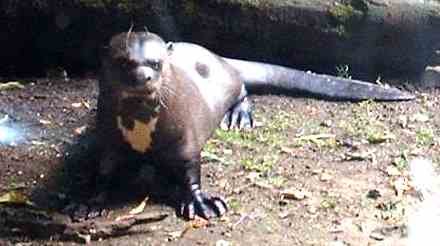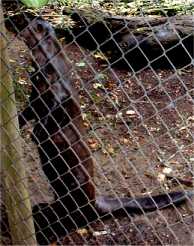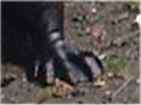Appearance and Anatomy of the Giant Otter
The information below comes from
Duplaix (1980),
Chanin (1985), Harris (1968),
Otternet
and personal observation; the pictures are taken from my original
photographs of William and Anja at the
Chestnut Centre.
Summary
 Giant otters are big - as long as a man and as heavy as an Alsatian
Dog. In shape, they are more sea lion-like than other otters, with
short, velvety fur, globular heads, long bodies, short legs and big,
flipper-like paws.
Giant otters are big - as long as a man and as heavy as an Alsatian
Dog. In shape, they are more sea lion-like than other otters, with
short, velvety fur, globular heads, long bodies, short legs and big,
flipper-like paws.
Size
| Sex | Total Length | Tail | Weight |
| Male | 1.5 - 1.8m (59 - 71") |
0.5 - 0.7m (20 - 28") |
26 - 32kg (58 - 70lb) |
| Female | 1.5 - 1.7m (59 - 67") |
0.5 - 0.7m (20 - 28") |
22 - 26kg (48 - 58lb) |
Head and Teeth
 The globular, slightly flattened head, with blunt, sloping muzzle,
and large, round, dark eyes give the Giant Otter a rather pug-like
appearance. The nose pad (rhinarium) is hairy, with two slit-like
nostrils, rounded when open, but closed by flaps of skin when
underwater - the nasal cavity has very well developed scroll bones,
denoting an excellent sense of smell. The eyes have huge sphincter
muscles to aid focussing, and can bulge visibly (there is a good
photograph of this on page 64 of
Bright (2000). Like most other placental mammals, Giant Otters
do not see red light - they view the world on a blue/green scale, where some shades of blue and green are indistinguishable from grey.
The ear pinnae are small, round, and set well
back on the head; they are also closed under water. It is likely
that while hearing is well developed, sound location is inexact as
the pinnae are almost immovable. The lips are thick and muscular.
The globular, slightly flattened head, with blunt, sloping muzzle,
and large, round, dark eyes give the Giant Otter a rather pug-like
appearance. The nose pad (rhinarium) is hairy, with two slit-like
nostrils, rounded when open, but closed by flaps of skin when
underwater - the nasal cavity has very well developed scroll bones,
denoting an excellent sense of smell. The eyes have huge sphincter
muscles to aid focussing, and can bulge visibly (there is a good
photograph of this on page 64 of
Bright (2000). Like most other placental mammals, Giant Otters
do not see red light - they view the world on a blue/green scale, where some shades of blue and green are indistinguishable from grey.
The ear pinnae are small, round, and set well
back on the head; they are also closed under water. It is likely
that while hearing is well developed, sound location is inexact as
the pinnae are almost immovable. The lips are thick and muscular.
The head has numerous long, strong, thick whiskers - mystical (moustache), superciliary (eyebrow) and gular (throat). These are richly supplied with nerve endings, leading to an enlarged coronal gyrus in the brain i.e. compared to paw-using otters such as Amblonyx cinereus, more of their brain is given over to analysing whisker input.
The teeth are large and strong, powered by massive cheek muscles, resulting in both the globular, cat-like head and a very powerful bite. The dental formula is
Body
 The neck is thick and muscular, and in males can be as thick as the head.
The body is long and low, with a broad, muscular pelvis and narrow shoulders. Giant Otters are slender, and their ribs show noticeably through their thin fur. Carrying extra fat would not be useful in a tropical climate.
The neck is thick and muscular, and in males can be as thick as the head.
The body is long and low, with a broad, muscular pelvis and narrow shoulders. Giant Otters are slender, and their ribs show noticeably through their thin fur. Carrying extra fat would not be useful in a tropical climate.
The lungs are particularly large, with a large tidal volume, resulting in the absorption of more oxygen from each breath than other mammals, which helps when swimming underwater ( Frankfurt Zoological Society Giant Otter Project).
They possess two sub-caudal anal scent glands which open inside the anus, and secrete a dark brown, musky, viscous liquid; these can be contracted voluntarily or as a reflex upon sudden alarm.
Tail
The tail is very thickly muscular at the base, then flattened dorsoventrally, with a noticeable bilateral flange for the last two-thirds, like a sword blade. The tail tip is rounded. The tail fur is particularly short.Legs and Paws
 The forelegs are short and stout, being heavily muscled. The forepaws are large, naked below, with strong toes and claws, thickly webbed to the fingertips, and when fanned out, are almost circular. The hind paws are very large, like clown boots! All otters are plantigrade, i.e. they place their feet flat on the ground. This is particularly noticeable with Giant Otters, especially on a muddy surface when they are in a hurry - they slap along almost like sea lions.
The forelegs are short and stout, being heavily muscled. The forepaws are large, naked below, with strong toes and claws, thickly webbed to the fingertips, and when fanned out, are almost circular. The hind paws are very large, like clown boots! All otters are plantigrade, i.e. they place their feet flat on the ground. This is particularly noticeable with Giant Otters, especially on a muddy surface when they are in a hurry - they slap along almost like sea lions.
Fur
 The fur is very short, with guard hairs only 8mm (5/18"), and under fur 4mm (3/16") long. It is very dense - water never reaches the skin - and is very soft and velvety. It ranges in colour from fawn through reddish brown to deep chocolate brown, appearing darker and shiny when wet.
The lips, chin, throat and chest are spotted and splashed with lighter markings, from creamy white to yellow-buff, with sharply defined edges. These markings vary from a few spots to a bib, and are unique to each otter; researchers use these markings to identify particular animals.
The fur is very short, with guard hairs only 8mm (5/18"), and under fur 4mm (3/16") long. It is very dense - water never reaches the skin - and is very soft and velvety. It ranges in colour from fawn through reddish brown to deep chocolate brown, appearing darker and shiny when wet.
The lips, chin, throat and chest are spotted and splashed with lighter markings, from creamy white to yellow-buff, with sharply defined edges. These markings vary from a few spots to a bib, and are unique to each otter; researchers use these markings to identify particular animals.
| Giant Otter |

